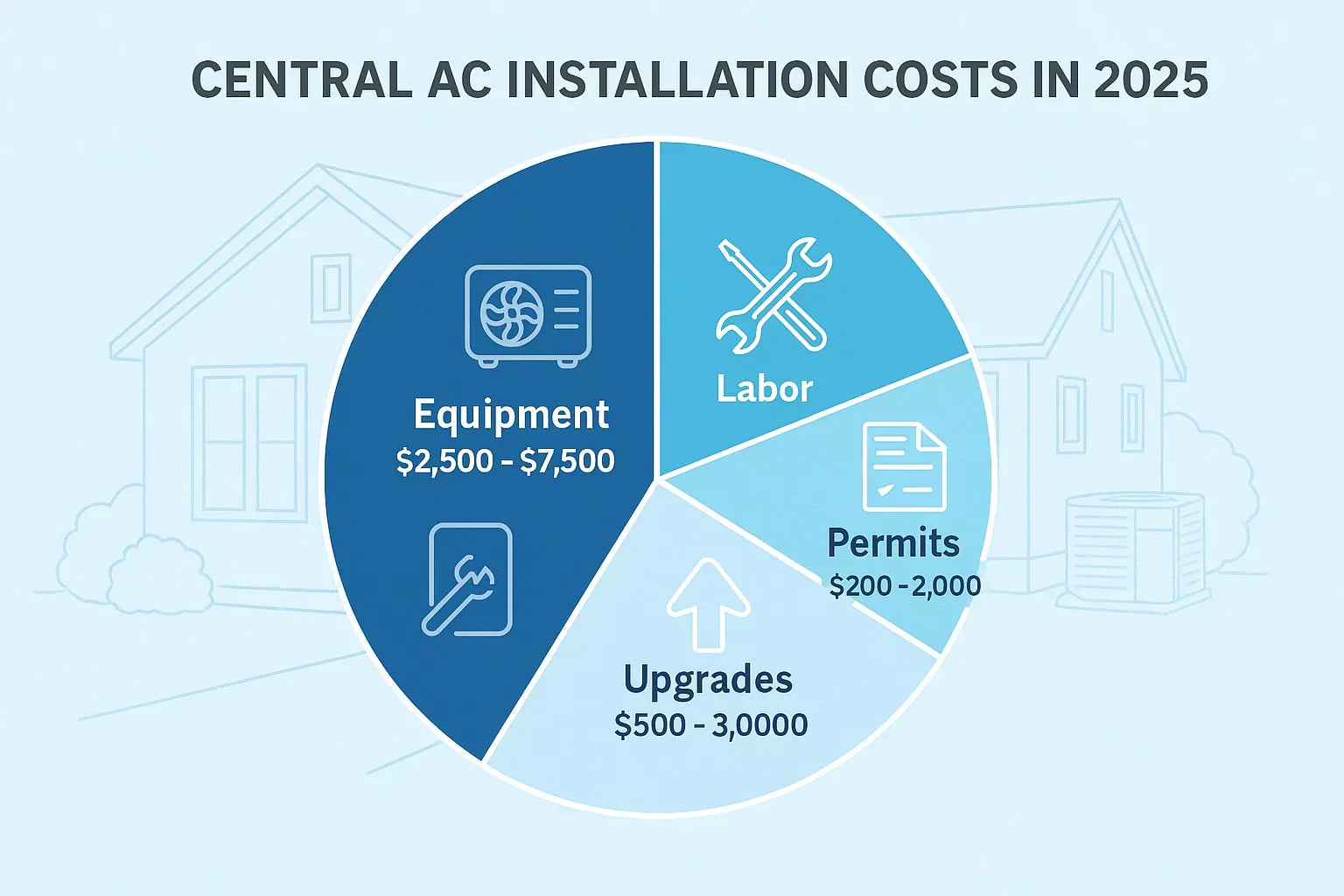By Alex Lane | Your Home Comfort Advocate
If you're planning to install or replace a central air conditioning system this year, you’re probably wondering: What’s it going to cost me in 2025? The answer depends on several key factors — but the good news is, you’ve got more tools and rebates than ever to help keep costs down.
In this guide, I’ll break down the average central AC system cost in 2025, explain what affects that price, and show you how to save on both installation and long-term energy use.
Average Central AC Costs in 2025
On average, a new central AC system in 2025 will cost between $4,800 and $8,500, including equipment and professional installation. But depending on your home’s size, ductwork, and location, the final bill could vary widely:
| System Type | Estimated Cost (Installed) |
|---|---|
| Budget System (SEER2 14.3–15.2) | $4,500–$6,500 |
| Mid-Tier System (SEER2 15.2–17.5) | $6,500–$8,500 |
| High-Efficiency System (SEER2 18+) | $8,500–$12,000+ |
💡 According to Angi, factors like brand, local labor rates, and duct condition can shift that price by thousands. Forbes also notes that smart thermostats and efficiency upgrades can push high-end systems beyond $12,000 — especially in large homes.
What Are You Actually Paying For?
Let’s unpack where your money is going:
🧱 Equipment
-
Outdoor condenser
-
Indoor evaporator coil or air handler
-
Thermostat (manual or smart)
-
Line set, pads, and other installation materials
👷 Labor
-
Removal of the old system
-
Ductwork modifications or repairs
-
Mounting, wiring, and refrigerant charging
-
Permit acquisition and inspection costs
➕ Add-Ons and Upgrades
-
Smart thermostat integration
-
Whole-home zoning system
-
Indoor air quality products (UV lights, dehumidifiers, air purifiers)
The more complex the installation, the more you’ll pay. That’s why proper planning — including load calculations and duct assessments — is critical.
Long-Term Costs: Energy Efficiency Matters
A high-efficiency system can save you hundreds every year — but it comes at a higher upfront price. In 2025, SEER2 ratings are the key to comparing performance.
-
A system rated 14.3 SEER2 (the minimum in southern U.S. states) is cheaper upfront, but uses more electricity
-
A 16.2–18 SEER2 system may cost $1,000+ more, but could save you $300–$500/year on your electric bill depending on usage
📘 Visit ENERGY STAR for a full list of certified high-SEER2 systems.
If you’re weighing which features are worth the extra investment, see my guide on Energy-Efficient Features to Look for in a 2025 Central AC — it’ll help you choose upgrades that actually pay you back.
How to Save on Your Central AC System
The best way to save? Be informed. Here’s where to start:
1. Right-Size Your System
Don’t rely on square footage alone. A Manual J load calculation takes insulation, windows, sun exposure, and room usage into account.
📘 Download the official ACCA Manual J guide to understand how pros determine the correct system size.
2. Tap Into Rebates and Tax Credits
Federal Tax Credit
Thanks to the Inflation Reduction Act, qualifying homeowners can claim up to $2,000 for installing a high-efficiency AC system.
Local Utility Rebates
Utilities often offer rebates ranging from $300 to $1,000 for SEER2-qualified systems. These vary by ZIP code, so check the DSIRE Rebate Finder for offers in your area.
Manufacturer Promotions
Major brands like Lennox, Carrier, and Trane often run seasonal promotions with rebates between $100 and $1,500 when you buy matched systems.
📘 Tip: Always ask your installer for the AHRI certificate and EnergyGuide label to ensure your system qualifies.
3. Compare Multiple Quotes
It’s tempting to go with the first installer, but you should:
-
Get at least three detailed estimates
-
Ask about system sizing (Manual J), brand reputation, and warranty terms
-
Ensure installers are licensed, insured, and NATE-certified
Also ask whether you’re being quoted for installation only, or if it includes permits, duct modifications, and smart thermostat setup.
4. Consider Direct-to-Consumer Models
Some brands, like MRCOOL or outlets like The Furnace Outlet, allow you to buy systems online and hire your own installer. This can shave off 20–30% of the markup from traditional supply chains.
⚠️ But be careful — choose a licensed installer, confirm warranty coverage, and make sure your system meets SEER2 minimums for your region.
Hidden Costs to Watch For
Here are a few expenses that can sneak up on you:
-
Duct replacement or sealing
-
Electrical panel upgrades (especially in older homes)
-
Drywall or attic access work
-
Permit and inspection fees
-
Disposal fees for old units
Get a full scope of work from your contractor in writing before signing anything.
Final Thoughts from Alex Lane
Replacing or installing a central AC system in 2025 is a big investment — but it doesn’t have to break your budget. With the right planning, rebate strategy, and installer, you can get a system that delivers comfort and efficiency for years.
To recap:
✅ Size it right
✅ Aim for the highest SEER2 your budget allows
✅ Compare quotes
✅ Stack rebates
✅ Don’t overlook installation quality
Want to see how the top models compare? Start with my Top 10 Central AC Units Compared guide for real-world performance, reliability, and cost insights.
Alex Lane
Your Home Comfort Advocate







